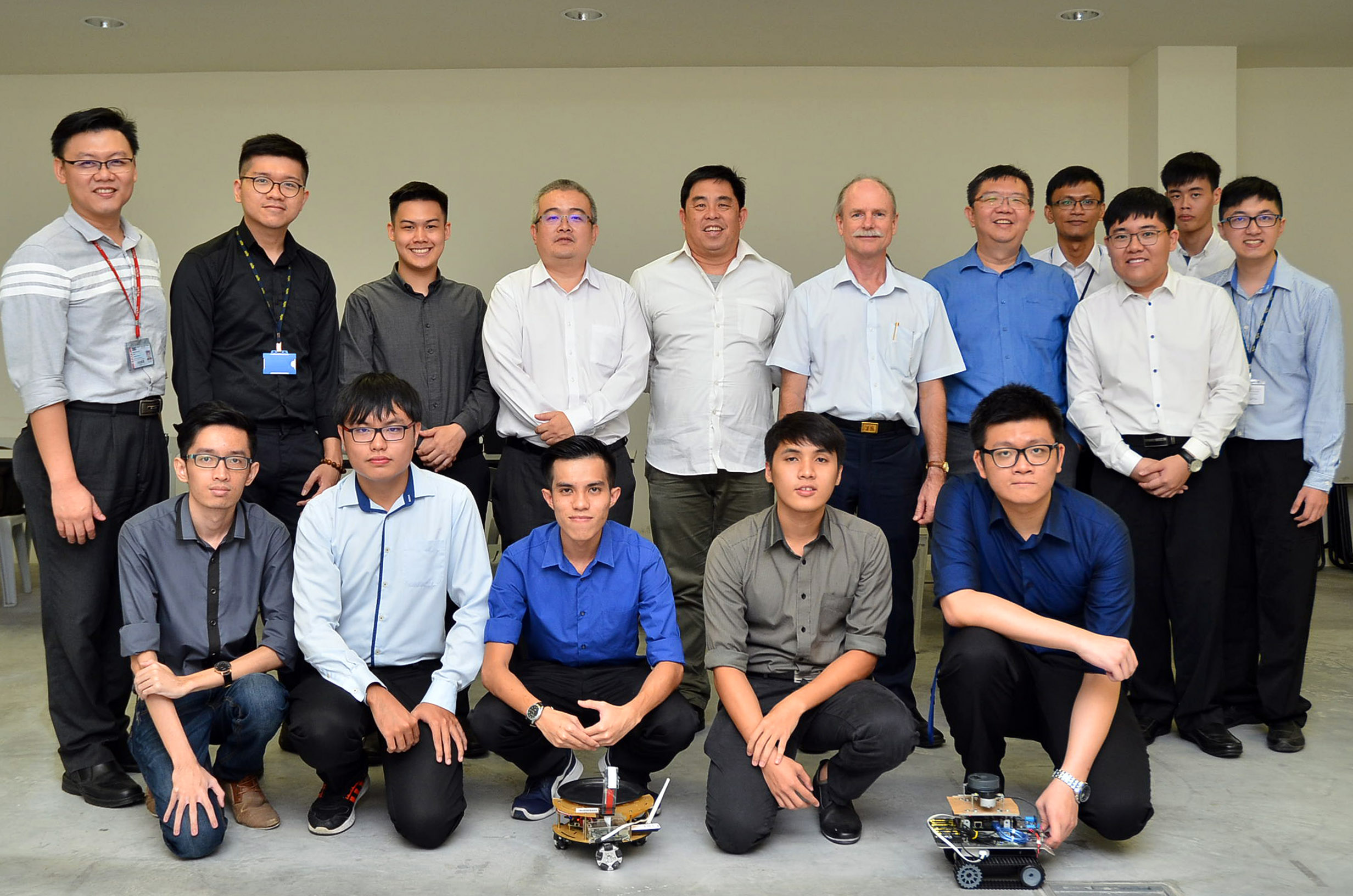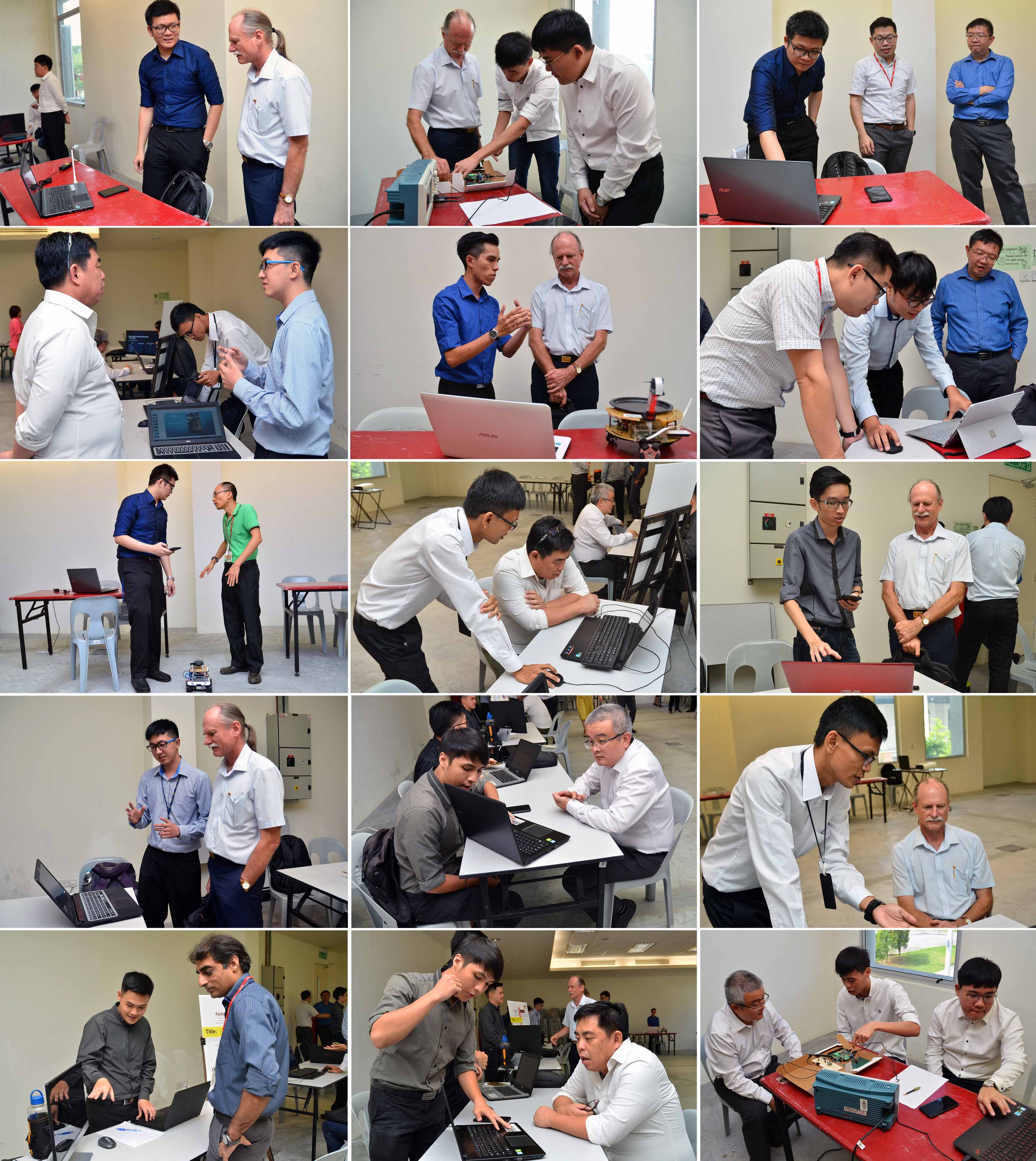


Back row: Dr Cheng (far left), Dr Kwong (fourth from left), Tan (fifth from left), Searcy (sixth from left) and Dr Liew (fifth from right) posing with students at the innovation meeting
An Industry Advisory Panel (IAP) Innovative Meeting was organised by the Faculty of Information and Communication Technology (FICT) on 11 July 2019 at UTAR Kampar Campus.
Present to evaluate the students’ presentations were industry advisors, namely Senior Vice President for Research and Development (Systems) of E-Genting Holdings Sdn Bhd Jonathan Searcy, Senior Manager of EV-Dynamic Sdn Bhd Dr Kwong Kae Hsiang and Vice President of MyTRIZ & InnoPlanet Consultant Tan Eng Hoo. Also present were FICT Dean Assoc Prof Ts Dr Liew Soung Yue, Deputy Dean for Academic Development and Undergraduate Programmes Ts Dr Cheng Wai Khuen, Deputy Dean for R&D and Postgraduate Programmes Ts Dr Lee Wai Kong, Department of Computer and Communication Technology Head Ts Dr Goh Hock Guan, Department of Computer Science Head Ts Dr Ooi Boon Yaik and Department of Information Systems Head Ts Dr Rehan Akbar.
The innovative meeting served as a platform for FICT undergraduate and postgraduate students to present their innovative Final Year Projects (FYPs) to the industry advisors and to obtain valuable feedback to improve their researches. Apart from enabling the students to understand the practicality of the research from the business and commercialisation perspectives, the practice also aimed to improve students’ abilities to comprehend and express the potential marketing strategies of their current projects.
Bachelor of Information Systems (Hons) Business Information Systems student Seow Yang Jiin’s research titled “Picture-based Password Scheme to Prevent Shoulder Surfing Attack” explained the benefits of using image as an authentication system. He elucidated that users’ passwords are susceptible to being exposed when people look over their shoulders, which is also known as shoulder surfing attack. With the picture-based password, the system would offer a safer user experience when users need to access important information in the public or open space.
Bachelor of Computer Science (Hons) student Ch’ng Chee Henn presented his FYP titled “A Multi-Mobile-Robot Control Framework for Parcel Sorting in Sorting Centres”. Though the technology has been utilised, Ch’ng aims to use his research to study better and improve the existing framework. He mentioned that his motivation comes from the fact that the usage of these sorting robots will increase over time, and that its function will greatly benefit the logistic field. The improvement of the framework will also enhance the robots’ function to provide better assistance to human work.
Bachelor of Information Technology (Hons) Computer Engineering student Darren Phang Ren Yee presented his FYP titled “S.L.A.M (Simultaneous Localisation and Mapping) Mobile Robot”. The reminiscence of his internship experience in Japan sprouted the idea to make a robot of similar capabilities, whereby it is able to make 2D mapping of areas with sensors to avoid obstacles. The main function of the robot is to assist human in carrying a big and heavy load.
The FYP titled “AR Animal Dissection Mobile Application with Group Interactions”, presented by Bachelor of Computer Science (Hons) student Edwin Lee En Yueng showcases virtualise animal dissection. Users of the mobile application will be able to see the realistic 3D image of the animal and virtually dissect it. He believes that the technology will benefit classroom learning, without costing the lives of animals, while also reducing waste and costs.
Bachelor of Information Systems (Hons) Information Systems Engineering student Lau Zheng Yi also created another educational and fun mobile application with his research titled “CNN Based Wild Animal Education Application”. The mobile application benefits its users with information on various animals that are displayed on the screen. It functions by using the device’s camera to scan the surroundings and AR animals will be displayed according to the habitat scanned.
Master of Science (Computer Science) student Siew Kar Hoe presented his research titled “Indoor Positioning System for Mobile Robots in Industrial Environment”. The system enables a robot to move from one point to the next in various directions. When successfully implemented, the robot with that system will be able to carry items and that would ease human work.
Meanwhile, Master of Science (Computer Science) student See Jin Chuan aimed to provide security features through his research titled “Tool Chain Development and Queue System Enhanced Security Coprocessor for FPGA-based Internet of Things (IoT) Processor”. With this feature, users’ data are protected. It also has a function of a software compiler which provides convenience to developer and programmers when developing programs. With the similar software, Master of Science (Computer Science) student Tan Beng Liong, with his research titled “Low Power Implementation” used it to improve energy consumption in all process-based electronic devices. He explained that the technology is able to lower battery consumption while maintaining its performance, hence not affecting the user’s experience.
Bachelor of Information Technology (Hons) Communications and Networking student Mohd Ibrahim bin Mohd Al-fadzillah presented his research titled “Online M.C Application” catered for students of UTAR. He explained that this online application will enable faster processing and eliminates the trouble of students having to submit the medical certificate manually. With attaching the scanned copy of the medical certificate, he mentioned that the online application will prevent loss or damage to the actual medical certificate as the data is stored online.
Unlike the usual auto-feeder for animals, the “Wireless Dispenser System: Pet Care” presented by Bachelor of Information Technology (Hons) Communications and Networking student Lee Wei Qi listed additional features to this dispenser. Apart from automatically dispensing food for the pet when the owner is not at home, the system also has a camera that allows the owner to check on their pets. A door management feature for the cage is also included. He further explained that pet recognition feature will also help the owner identify if it’s the right pet for that specific cage. He highlighted that this system will give pet owners a peace of mind when they need to travel, and save their cost on the need to rent pet hotels for their pet.
Bachelor of Information Systems (Hons) Business Information Systems student Joel Lim Yong Jin presented his research titled “Factors Affecting the Adoption of E-Government Services by Malaysian Citizens”. He aimed to use his research to identify the factors, determine the willingness to adopt E-Government services, and validate framework statistically. He believes that the research will benefit the government, relevant agencies and corporations who require that data. Apart from understanding the factors, Lim explained that the findings will act as a guideline for developers and policymakers when designing and executing similar services.
When asked of the feedback from the presentation, Searcy advised the students to be careful in selecting their projects. He mentioned that though the projects seem achievable, the reality of seeing the project come to fruit may require longer time and more effort, and students must be prepared for that. Overall, he commented that the software projects were progressing, while the hardware projects will face some challenges ahead. Meanwhile, Dr Kwong advised students to consider the consumers’ perspectives when designing their project. He also advised them to apply more analytical skills to their project, rather than having their project done for the sake of completing their assignments. Tan, on the other hand, mentioned that some projects are advance, and some have applied the fundamental and conceptualised the project very well. He also complimented the guidance provided by the lecturers and hoped that the good work continues in moulding student to not just be technically strong but to also become leaders in the industry as well. He also saw progress in the students’ projects compared to the previous year, but he hopes that students would speak with more confidence in their presentations.
Prior to the innovation meeting, a meeting was held with the faculty management committee. The aim of the meeting was to discuss with the industry advisors on improving the faculty’s curriculum and ensuring that the syllabus is updated and relevant to the industry. The industry advisors also provided their feedback regarding the updated ICT skills and requirements. Apart from Searcy, Dr Kwong and Tan, the additional advisors present at the meeting included Global IT Head of Central Technology at Hilti Group Suwin Karunarathne and Group CEO/Director of Hitachi Sunway Information Systems and PIKOM Representative Cheah Kok Hoong.

Students presenting their research to the industry advisors

Industry advisors and faculty management committee discussing on improving the syllabus
© 2019 UNIVERSITI TUNKU ABDUL RAHMAN DU012(A).
Wholly owned by UTAR Education Foundation Co. No. 578227-M LEGAL STATEMENT TERM OF USAGE PRIVACY NOTICE